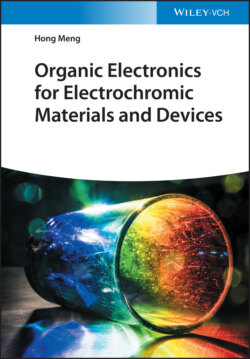Читать книгу Organic Electronics for Electrochromic Materials and Devices - Hong Meng - Страница 16
1.3.3 Coloration Efficiency
ОглавлениеColoration efficiency (CE) plays a fundamental role in the evaluation of the efficiency of charge utilization during the EC processes. It relates the optical absorbance change of an EC material at a given wavelength (ΔA) to the density of injected/ejected electrochemical charge necessary to induce a full switch (Qd). The higher CE value indicates a large transmittance change with a small amount of charge, which makes more effective use of the injected charge. CE value can be calculated using the following equation:
where Tox and Tneut are the transmittances in the oxidized and neutral states, respectively, and Qd represents the injected/ejected charge per unit area, which could be obtained from the integral area of the current density curve during voltage switching (Figure 1.7).
Figure 1.7 The calculation of Qd.
Source: Hsiao et al. [27].
Very similar to the previous parameters contrast and switching time, the CE values are also different depending on the selective wavelength, as shown in Figure 1.8. Several kinds of CE value of the same EC materials are exhibited: in most reported literature, the CE of characteristic wavelength reaching the maximum contrast (λmax) is calculated, which is the maximum CE value (CEmax). Also, the CE value at 555 nm is calculated for comparison in different publishes because of the highest sensitivity of human eyes at 555 nm as well as the photopic CE based on the photopic transmittance mentioned in the contrast part, which considered the light transmission over the wavelength range between 380 and 780 nm normalized with the spectral sensitivity of the human eye. Therefore, more plot of CE values should be obtained rather than single‐valued CE values, to give more information about the performance of EC materials.
Figure 1.8 Different types of CE value of the same EC materials.
Source: Kraft [25].
In addition, when insightfully considering the injected/ejected charge Qd, we can find it in fact to consist of three part: faradaic charge QF associated with doping/de‐doping, capacitive charge QC due to the capacitive nature of the ECD, and parasitic charge QP associated with electrolyte/impurity reactions. Among them, the faradaic charge is the source of redox activity leading to chromic change actually. Therefore, Fabretto et al. reported a new technique for measuring CE by extracting the faradaic charge from the total charge and calculated the only faradaic charge‐based CE value [29]. As we discussed, the total charge flow is simply the addition of the three individual charge flows and is given by
where the parasitic current was a small component (approximately <2%) compared with the other two and therefore can be ignored. Then the time–evolution total current flow can be described as following:
where n is the number of electrons transferred per molecule, F is the Faraday constant (96 500 C/mol), A is the electrode area (cm2), C0 is the concentration of species in the bulk solution (mol/cm3), D is the apparent diffusion coefficient (cm2/s), t is time in seconds, I0 is the maximum current flow at t = 0, R is the cell resistance, and C is the double layer capacitance. Then fitting the experimental data to this equation and substituting the constant k, at last, a plot of the time–evolution faradaic current will be obtained, and the corresponding faradic‐corrected CEs can be calculated. Usually, the faradic‐corrected CEs are larger than the uncorrected results, because the total charge ingress/egress (i.e. Qd) is larger than the faradic charge (i.e. QF).
